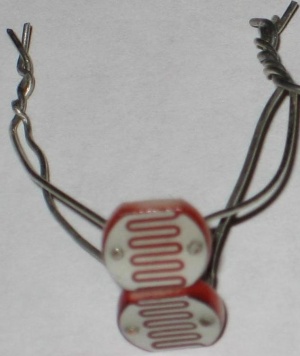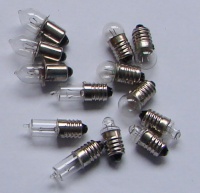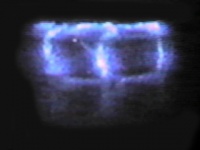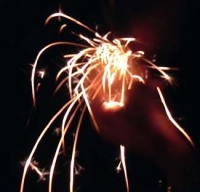Light Sensing Devices
Photoresistor
|
Photoresistors are a type of resistor whose resistance varies with the intensity of the light hitting the surface of the sensor. Typically, a brighter light will cause the resistance to drop closer to zero, though never reaching it.
|
Sample Circuit
|
|
 This picture doesn't show a battery, but you need one! |
 Two photoresistors wired in parallel. |
|
 Used the two large cells from this package. |
Photodiode
Photodiode
Photogates
|
Photogates are common physics lab equipment used for detecting the passage of an object. They can use either photodiodes or photoresistors and can be purchased, borrowed, or constructed.
|
Light Generating Devices
LEDs
|
LEDs are light emitting diodes. Being diodes, they are polarized. The longer lead is the positive one. If the lense has a flat face, while the rest is rounded, the flat face should correspond to the negative side. LEDs should be current limited using a resistor in series with them.
|
Light bulbs
 A small bulb from a flashlight |
Low voltage DC light bulbs can be convenient light sources. Unlike LEDs, they do not require a current limiting resistor, though they will die of natural causes (probably not within the lifespan of your Mission though).
|
Lasers
 A laser bouncing off of mirrors |
Lasers may or may not be allowed and certain types are restricted. Check the NSO website and the current rules for more info. Lasers are the perfect way to demonstrate diffraction or reflection.
|
Sparks
Triboluminescence
 Wintergreen mints can be sparked together |
Not a very easy light source, but wintergreen mints, when struck together, can generate small sparks.
|
Flint and Steel/Sandpaper
 Flint can be used with steel or sandpaper to generat sparks |
If a piece of flint is touched by a spinning disk or drum of sandpaper, a large number of sparks can be generated. These can be detected particularly easily if the mechanism is in a dark box. There are enough sparks to potentially light something sufficiently flammable, if that were desired.
|
Luminol
Glowsticks can be opened and the chemicals seperated for later use. Luminol is sometimes contained.
Cut the top off of the stick and pour the liquid inside into an opaque container. Carefully extract the glass tube inside the plastic glowstick tube. Put the glass tube in another opaque bottle. If you break the glass inside the bottle then you can just use a syringe or pipet to extract the chemical. Combine the two chemicals in your machine to generate light. Use opaque containers and do not open the glowstick packaging until necessary because some of the chemicals may photodegrade, rendering them weak or useless. Some of the chemicals also stain in interesting and permanent colors.
Light Transmitting Devices
Fiber Optics
 A bundle of fiber optic cables |
If fiber optics are required by one year's tasks or if you simply need to get light into a smaller space than you can fit an actual light, fiber optics can be used to carry light from the emitter to some distance away. Fiber optics can be ordered in various diameters or many small diameter strands can be found in novelty or party supply shops. Clear hot glue sticks can be used as a low-quality stand-in.
|















